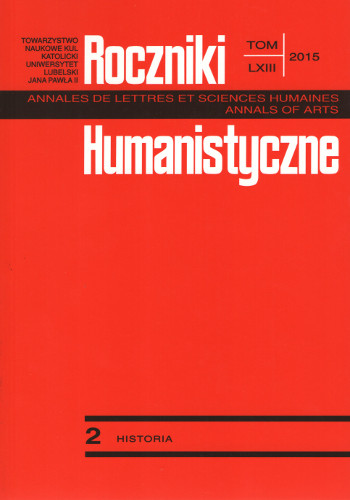Szpitalnictwo zakonne w średniowiecznej Polsce
Hospital service offered by religious orders in the mediaeval Poland
Author(s): Marian SurdackiSubject(s): Middle Ages, 6th to 12th Centuries, 13th to 14th Centuries, 15th Century
Published by: Towarzystwo Naukowe KUL & Katolicki Uniwersytet Lubelski Jana Pawła II
Keywords: men’s religious orders;hospitals;poorhouses;monastic orders;canon hospitaller orders;military-hospitaller orders;charity work;charity;women’s religious orders
Summary/Abstract: The development of hospital service in Poland was connected with the acceptance of baptism, with the development of the Church organization, and first of all with the coming of eremite-monastic orders: Benedictines and Cistercians to Poland. Admittedly their main mission was not charity work, but according to their rules they ran hospices and hospitals that were located inside their monasteries, and they helped those in need and treated the ill. Altogether the orders ran 28 hospitals (the Benedictines ran 11, and the Cistercians – 17).However, it is not eremite orders that were the forerunners of hospital service and charity institutions in the area of Poland in its first centuries, but the orders of regular canonry that were developed since the second half of the 12th century, whose charity work, and especially running hospitals, became their main mission recorded in their rules. They were Canons Regular living under the rule of St Augustine, the Order of the Holy Sepulcher (the Order of Miechów), Canons Regular of the Holy Spirit, the Knights of the Cross with the Red Star, the Hospital Brothers of St Anthony.The above discussed group of orders of regular canonry was closely connected with military orders that were established on the basis of the crusade movement and armed crusades to Jerusalem as well as the pilgrimage movement that accompanied them. Their aim was to run hospices and hospitals for pilgrims and other people who were in need. Military orders, like the earlier mentioned orders of the Holy Spirit, the Holy Sepulcher or the Knights of the Cross with the Red Star, were called orders of the cross, since they accepted the sign of the cross as their symbol. In total, in the area of the territorially changing Poland, including Silesia and the areas conquered by the Teutonic Order, about 45 hospitals may be counted up that were run by Canons Regular and military-hospitallers. A decided majority of hospitals run by Canons Regular and military orders were concentrated in the south-west and north-west parts of Poland, especially in Silesia and Pomerania. The orders of Holy Spirit, of St Anthony and the Knights of the Cross with the Red Star were devoted to charity work in the greatest degree, whereas the order of the Holy Sepulcher, the Knights Templar, the Knights of Malta and the German Teutonic Order carried out the double, hospitaller-military mission.Women’s orders also did charity work and ran hospitals, albeit to a lesser degree. The Sisters of the Holy Spirit played the most important role in this field. Also the Benedictine and Cistercian nuns dealt with charity. However, they did so on the margin of their basic activities.The so-called beguines – groups of women most often keeping close to Dominican or Franciscan churches and keeping to the rules of community life accepted for lay people connected with these orders, that is for the so-called Third Order – were to a little greater degree involved in running hospitals. On the other hand, the Capuchin Poor Clares, the Magdalene Sisters, the Bridgettines, the Norbertines or the Franciscan nuns were occupied with hospitals only sporadically.
Journal: Roczniki Humanistyczne
- Issue Year: 63/2015
- Issue No: 02
- Page Range: 49-98
- Page Count: 50
- Language: Polish

